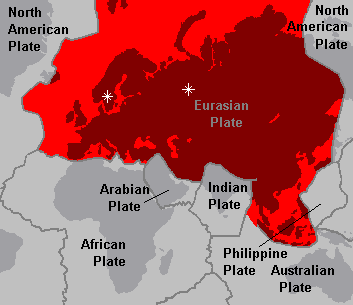
| |
 |
![]()
The Eurasian plate is 85% land mass with a very undefined plate boundary on its southern border connecting to the African, Indian and Australian plates. My guess is, this border will be very defined after the pole shift because of the extreme earthquake activity in this area. The city of Pechora is located almost in the center of the plate, longitude of 59 degrees east and latitude of 64 degrees north in the Ural Mountain range. Located 800 miles from the border of Finland to the east, 3000 miles from the Pacific ocean and 300 miles south of the Arctic ocean at an elevation of about 3000 feet. Probably just about any where south of Pechora in the Ural Mountains would be a good spot to be as they should give good protection.
There is no shown volcanic activity north of the Urals. There is old volcanic activity south near Africa with sparsely scattered earthquake activity within a few hundred miles. The Urals have resources that could be available after the pole shift for these people.
 |
|
Because of the massive size of the Eurasian plate and the amount of people on it, I think a second location should be chosen for this plate as well. In the area around the cities of Sveg and Mora in Sweden is a good choice. They are located at latitude of 62 degrees north and longitude of 14 degrees east at an elevation of 1000 to 6000 feet. This area is located 200 miles east of the Norwegian Sea and east of the mountain chain and 100 miles west of the Baltic sea. There is no shown volcanic activity north of this area and has minimal earthquake activity. This area is closer to the Atlantic rift, but should be pushed away from most activity. This area may get splashed with tidal waves. This will probably be its worst downfall. Be prepared. Sweden produces copper, lead, zinc, silver, and arsenic (and from personal knowledge, this should be a gold producing area as well.)
Offered by Clip.
Clipper states that Sveg and Mora are safe places. However, Mora is only at about 160m or 525 feet above sea level. If the pole melt and the sea level, worldwide, rise by 650 to 700 feet within two years as ZetaTalk predicts, Sveg is OK though, at about 360m or 1180 feet, but Mora is not.
Offered by Jan.